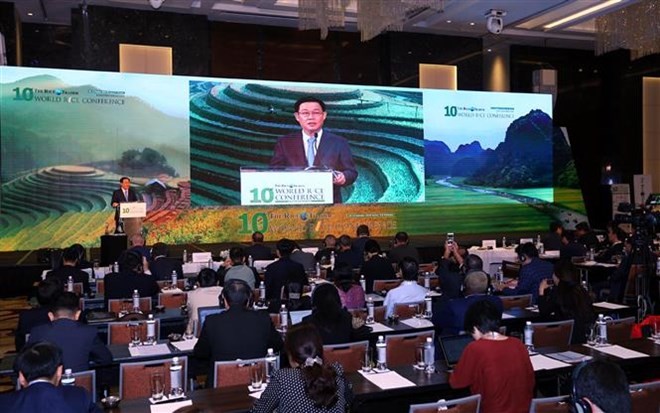
Attending the event were Deputy Prime Minister Vuong Dinh Hue, leading officials of Vietnam’s Ministries of Industry and Trade, and Agriculture and Rural Development, representatives of the rice sector of the world’s major importers and exporters and major companies, and experts from more than 30 nations and territories all over the world.
Minister of Industry and Trade Tran Tuan Anh said that Vietnam holds an increasingly important role in coordinating with rice importers, exporters and partner organisations to effectively participate in the globe’s rice product chain and food security.
The country’s rice export market development strategy for the 2017-2020 period with a vision to 2030 approved by the Prime Minister focuses on developing export markets to increase the efficiency of and boost rice export, thus helping raise farmers’ incomes, ensure domestic food security and social welfare, and protect the eco-environment.
The strategy also targets rice export market development with increasing competitiveness, building Vietnamese rice trademark, and intensifying connectivity through a value chain from production to consumption and export, Anh added.
Jeremy Zwinger, TRT President and CEO, said Vietnam’s hosting of the 10th conference shows its Government’s attention and commitments to the development of the rice sector and the trade of the grain.
With a message of “investing in the rice sector in future”, delegates discussed global trends on rice production and trade in 2018 and the following years, shared experience in producing rice sustainably, controlling the supply chain, developing rice trademark and apply technology in this sector.
Many stressed unpredictable changes in global trade, especially rice trade, as rice is a sensitive commodity with high requirements on food safety and environmental protection.
Deputy PM Vuong Dinh Hue affirmed that agriculture and rural development is a major policy of the Vietnamese Party, State and Government, in which rice production and export play an important role in contributing to ensuring food security for Vietnam, the region and the world at large.
Despite a strong industrialisation and modernisation process, rice fields now account for around 60 percent of Vietnam’s total arable area, and rice production is an essential source of livelihood for nearly 9 million farmer households in the country.
After more than 30 years of renewal, Vietnam has risen from a poor country which had to import food to one of the three largest rice exporters of the world with an average volume of 5-6 million tonnes.
Last year, Vietnam exported nearly 6 million tonnes of rice, earning 2.6 billion USD, up 21 percent in volume and 22 percent in value year-on-year. Vietnamese rice is available in 150 nations and territories, Hue said, adding that Vietnam is eyeing potential markets in Europe, America and Oceania, along with its traditional ones such as China, the Philippines, Malaysia, Cuba and African nations.
Vietnamese rice also meets all criteria to enter the most choosy markets in the world, as the country has paid much attention to applying high technologies in production, and develop organic agriculture, he affirmed.
According to him, the Vietnamese Government has set a target of intensifying production and export connectivity through a value chain, ensuring the quality of exported rice, and entering more deeply into the global rice value chain so as to build and confirm the prestige of Vietnamese rice trademark.
























